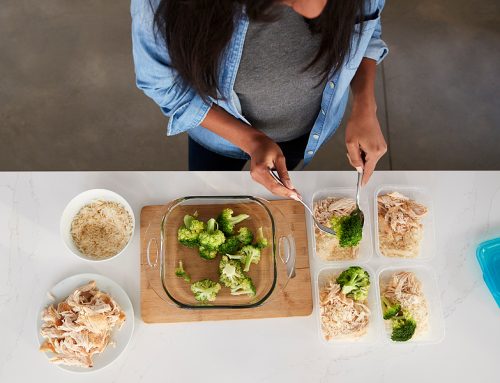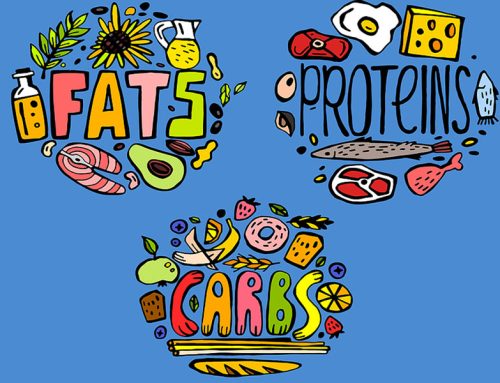The topic of meal planning for improving body composition is terribly misunderstood. On my flexible meal planning webpage, I listed the 8 biggest meal plan myths, but there are even more myths than that.
A lot of the confusion is simply in defining what a meal plan is. When I say “meal planning” what pops up in most people’s heads is often completely different than what I’m talking about and recomending.

For example, when I say “meal planning” or “meal plan” I’m not referring to “meal prep.” Meal prep is where you cook in batches and put complete meals in plastic containers for later. That can be helpful, but it’s not necessarily meal planning.
I’m not referring to daily macro tracking either. That can be helpful too, but tracking alone is definitely not planning.
I’m also not talking about ordering pre-made food online from a meal prep company. Sometimes their sites even call it a “meal plan,” but that’s not meal planning either, it’s selling you pre-made meals. Great if you can afford it, but even then, nope, it’s still not meal planning as I define it.
And I’m DEFINITELY not talking about buying a sheet of paper (or PDF) with a pre-made meal plan from some diet coach or nutrition guru. Trying to follow a generic meal plan or someone else’s meal plan is the WORST idea ever.
When I say you should meal plan (verb), here’s what I mean:
First, you calculate your calories and macronutrients (aka “macros” – protein, carbs, and fat). Those four numbers are the framework for your plan. It’s also how you know how much to eat to lose fat, maintain, or build muscle.
Then, you use an electronic tool (software, app, or at least a spreadsheet) to sketch out a full day of eating, food by food, meal by meal and your plan shows the calories and macro grams, not just the food and serving size.
You also choose a meal schedule (like breakfast, lunch, dinner or if you’re more into the bodybuilding side, you might have 4 to 6 feedings a day). Then you drop foods into each meal, including the serving size and adjusting that portion based on your calorie target.
The planning tool (app, software) displays your calories and macros in grams for each food, each meal and the entire day.
You do this in advance, so you’re starting every day already knowing what you’re going to eat. At the very least, you have daily macro goals, a schedule and a meal template, then you can plug in foods on the fly.
The benefits of having a meal plan are massive: You can print it out and think of it as your eating goal for the day. You can tape it to your fridge (and to your goal board /vision board). It keeps you feeling focused and directed.
It’s a form of pre-commitment too, which means it helps you overcome impulsiveness and temptation and reduces decision fatigue and willpower failure because you already made your eating decisions ahead of time.
Not to mention, choosing the calories and macros correctly and planning your eating around those numbers is the optimal way to get lean and build muscle.
We could clarify terms by calling this “macro-based meal planning.”
With this definition in mind, now, let me share 5 of my top tips for making this kind of meal planning work for you.
1. Know the difference between macro tracking and meal planning
Most people think that meal planning is macro tracking, but they’re two different things.
Macro tracking is setting targets for your daily intake of calories and grams of protein, carbs and fat. Then you record what you eat by entering it into a food journal, which today is usually a mobile app or online software.
But if you didn’t know what you were going to eat in advance, then you didn’t have a meal plan, you simply recorded your food intake on the fly. That’s macro tracking, and it’s reactive.
If you plan out your day of eating in advance, that’s proactive. That’s meal planning.
Macro tracking by itself has value – it’s a great awareness and accountability tool. I’m not knocking it at all. Some folks do both meal planning and macro tracking. But meal planning, where you go into each day already knowing what you’re going to eat, at least having a template for what you’ll eat, is superior on many levels.
2. Customize everything in your meal plan
Most people want to be handed a meal plan by someone else. Typically, people look for meal plans in diet books, or buy meal plan templates from diet coaches.
However, any pre-made meal plan, by definition, is a generic meal plan. If it’s already printed in a book, it was not made for you. A good diet coach or dietician could help you create a customized meal plan, but the industry is rife with coaches selling expensive cookie-cutter meal plans.
It’s also very tempting to see someone else had great success with fat loss (or muscle gain) and then want to follow their plan. But it’s not your plan. It’s theirs.
These are all prime reasons people fail with meal plans. Your plan must be personalized just for you including the calories, macros, and foods. Your meal frequency and schedule must also be customized and fit your lifestyle and preferences.
This means don’t follow a bodybuilder’s meal plan with six meals a day if you don’t like eating that often and all that meal prep and eating is only a pain in the butt. And this means don’t follow that trendy new time-restricted feeding (intermittent fasting) diet if you don’t like that eating schedule either. (Tip: when you eat matters on some levels, but it doesn’t matter as much as we used to believe).
Never use generic meal plans except maybe as inspiration for food, meal and recipe ideas.
3. Don’t restrict foods
Most people put together a meal plan based on a list of good foods to eat and bad foods to avoid. That’s the way the diet industry has operated for years. You’re told that if you simply avoid certain foods, the fat will melt right off. Usually phrased as “never eat this.”
I think most of us have done it. And most of us on the coaching side have given out these lists as well in the past. But times have changed and nutrition guidelines have evolved. We understand the mental side better than ever.
Psychologists have been studying this food restriction mentality and discovered a massive irony. Food restriction directly correlates with diet failure. The thing that’s supposed to make popular diets work – a focus on what you can’t eat – is the very thing that makes it fail.
When the goal is fat loss, the right thing to focus on is a caloric deficit. Or differently stated, proper portions.
If you’re in a calorie deficit, you can eat anything you want and you’ll still get leaner. Just remember, that’s not suggesting a low calorie junk food diet is healthy. We’re simply saying that foods don’t make you fat, excess calories do.
For long-term success, eat the foods you like.
4. Avoid the perfectionism trap
Trying to be perfect with your nutrition, especially number-based nutrition, will not necessarily give you better results because of your precision, it could actually increase your risk of failure. Plus, perfectionist attitudes toward planning and tracking can lead to overwhelm and an unhealthy preoccupation with food
The problem is most people think that since they’ve set macro targets – a specific number of grams for protein, carbs and fat, with a specific number of calories – that they must hit them on the bullseye.
Nope. The truth is, while it’s important be close on calories, if you’re a hundred over or a hundred under, it won’t make much difference. If you’re over or under 5% on macros, that won’t make much difference either. It matters even less when it comes to fat and carbs.
It’s important to be close on protein, but what most people don’t realize is that there is a huge range for acceptable intakes of carbs and fat. People lose fat on high carbs, medium carbs, and low carbs; on high fat, medium fat, and low fat.
Once you discover how much leeway you really have for carbs and fat, a lightbulb goes off and you suddenly see the futility in trying to nail your daily macros with a perfect landing every time.
Try to get reasonably close on protein and calories, but aside from that, don’t be a macronutrient micromanager.
5. Get as much or as little food variety as you want.
One of the big myths of meal planning is that if you follow a meal plan, that means you’re being rigid, inflexible and you’ll get bored because you’re locked into eating the same thing every day.
Except you’re not locked in. Who’s locking you in?
Not only can you create more than one meal plan but also, you can look at a meal plan as a template from which you can exchange or rotate foods. It’s not a prescription that must be followed the same every day.
If you create and save a bunch of your favorite meals in your app or meal planning software, and if you make them all approximately the same calories and macros, you can rotate them and you don’t even need to log / track it – the calories and macros are already the same the way you saved them.
You can swap individual foods too. Once you learn about food exchange groups and you have some kind of portioning or plating system, it’s as easy as 1-2-3.
Our classic system is to visualize your plate and put on it a lean protein portion, a fibrous carb (veggie) portion, and a starchy carb portion, with maybe a thumb size part of it fat.
Or if you prefer (if you’re like me), eat mostly the same thing every day. There’s not only nothing wrong with that, this actually makes it much easier to lose fat for a variety of reasons.
I’ve got lots more to share but that’s it for today.
Also if you have questions please email me or post in the comments below and we can do some reader Q & A columns in upcoming blogs. What do you want to know the most about meal planning? What do find the hardest or most challenging part of it?
See you next week. Until then,
Train hard and expect success!
Tom Venuto,
Founder & CEO, Burn the Fat Inner Circle
Author of Burn the Fat, Feed the Muscle
Author of The BFFM Guide to Flexible Meal Planning For Fat Loss
PS. If you’re interested in learning about both macro based meal planning, as well as what to do when you’re not tracking strictly, then don’t forget to check out the new e-book – it explains everything! Take a look :
The Burn The Fat, Feed The Muscle Guide To Flexible Meal Planning For Fat Loss

Tom Venuto is a natural bodybuilding and fat loss expert. He is also a recipe creator specializing in fat-burning, muscle-building cooking. Tom is a former competitive bodybuilder and today works as a full-time fitness coach, writer, blogger, and author. In his spare time, he is an avid outdoor enthusiast and backpacker. His book, Burn The Fat, Feed The Muscle is an international bestseller, first as an ebook and now as a hardcover and audiobook. The Body Fat Solution, Tom’s book about emotional eating and long-term weight maintenance, was an Oprah Magazine and Men’s Fitness Magazine pick. Tom is also the founder of Burn The Fat Inner Circle – a fitness support community with over 52,000 members worldwide since 2006. Click here for membership details





Leave A Comment